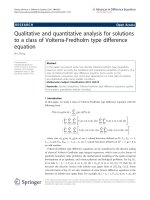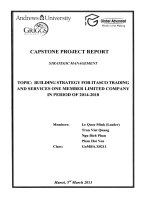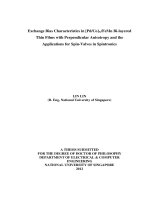Correlation and path analysis for different characteristics in germplasm of niger (Guizotia abyssinica (L.f) Cass)
Bạn đang xem bản rút gọn của tài liệu. Xem và tải ngay bản đầy đủ của tài liệu tại đây (285.99 KB, 7 trang )
Int.J.Curr.Microbiol.App.Sci (2019) 8(8): 2577-2583
International Journal of Current Microbiology and Applied Sciences
ISSN: 2319-7706 Volume 8 Number 08 (2019)
Journal homepage:
Original Research Article
/>
Correlation and Path Analysis for Different Characteristics in
Germplasm of Niger (Guizotia abyssinica (L.f) Cass)
Shubhangi Patil, V. V. Bhavsar* and Sweta Deokar
Department of Agricultural Botany, College of Agriculture,
Dhule-424 004 (MPKV),
(M.S.), India
*Corresponding author
ABSTRACT
Keywords
Correlation
coefficient, Path
analysis,
Germplasm
Article Info
Accepted:
22 July 2019
Available Online:
10 August 2019
The present investigation entitled “Correlation and Path Analysis for
Different Characteristics in Germplasm of Niger (Guizotia abyssinica (L.f)
Cass.)” was undertaken during Kharif 2018. The experiment was carried
out in Randomized block Design (RBD) with two replications to derive
Correlation coefficient and Direct and Indirect effects in 45 germplasm of
Niger. In 45 genotypes it has been revealed that, that number of primary
branches per plant, number of secondary branches per plant, number of
capitula per plant, number of seed per plant, diameter of capitula, 1000 seed
weight were good indicators of seed yield per plant along with highly
significant correlation in the desirable direction towards seed yield per plant
indicated the true and perfect relationship between seed yield and these
characters suggesting direct selection based on these character would help
in selecting the high yielding genotypes in niger.
Introduction
Niger (Guizotia abyssinica (L.f) Cass) is
named after the French historian Guizot. It
belongs to the family Compositae/Asteraceae,
tribe Helianthoides and subtribe Verbeninae. It
is an oilseed crop cultivated in Indian
subcontinents and East African Countries. It is
self-incompatible crop having diploid
chromosome 2n=30. It is minor crop grown
mostly in India and Ethiopia where it is known
as Ram til, Kala til, Karala, Gurellu, Tilangi
and Neuk, Noog and Nug. Niger is the native
of highlands of Ethiopia and originated from
G. scabre subsp. Schimperi, where it is a
common weed in fields with grown Niger. The
wild form has oil content of 24 to 35%, while
the cultivated Niger has 36 to 42% oil with
fatty acid composition of 75 to 80% linoleic
acid, 7 to 8 % palmitic and stearic acid and 5
to 8 % oleic acid. Indian Niger oil reported
higher in oleic acid (25%) and lower in
linoleic acid (55%). Niger has a 10-30%
protein content. Niger is a dicotyledonous
herb, moderately to well branched, grows up
to two meter tall. Niger plant like other
2577
Int.J.Curr.Microbiol.App.Sci (2019) 8(8): 2577-2583
compositae is highly cross pollinated oilseed
crop mostly grown on marginal and sub
marginal land.
In India the Niger is grown on an area of 2.61
lakh ha mainly during Kharif, and average
productivity in India is 321 kg/ha with
production 0.84 lakh tonnes. India is the
largest exporter of Niger in the world to USA,
Netherland, Italy, Germany, Belgium, and
Spain are the regular buyer. Whereas, USA is
the largest buyer in the world. The export of
the Niger seed continuously increased. In
Maharashtra, it is grown on an area of 0.141
lakh ha with the production of 0.023 lakh MT
and productivity is 165 kg/ha (2016-17). India
tops in area, production and total export for
Niger in the world.
Correlation studies provide knowledge of
association among different characters and
grain yield. The study of association among
various traits is useful for breeders in selecting
genotypes possessing groups of desired traits.
The
correlation
coefficients
become
insufficient for using yield components as
selection criteria to improve grain yields. It is
reasonable to know whether any yield
components has a direct or indirect effect on
grain yield, so that selection studies can be
carried out successfully.
Correlated response: Two characters say x and
y, are correlated. A change in the mean of x
through selection will cause an associated
change in the mean of y also. This change in y
brought about through indirect selection on an
associated character x is known as correlated
response (Singh and Chaudhary, 1977).
The path coefficient analysis provides a more
realistic picture of the relationship as it
considers direct as well as indirect effects of
the variables by partitioning the correlation
coefficients.
Correlation and path analysis estimates
between yield and other characters are useful
in selecting desired plant type in designing an
effective breeding programme. When change
in one variable causes the change on other
variable, the variables are said to be
correlated.
Keeping the above facts a view, the present
investigation entitled, “Correlation and Path
Analysis for Different Characteristics in
Germplasm of Niger (Guizotia abyssinica
(L.f) Cass.)” was proposed to gather
information on the following objectives:
To better insight into the cause and effect
relationship between pairs of characters, study
of correlation in conjunction with path
analysis is essential.
Materials and Methods
The experimental material comprising forty
five genotypes of Niger were grown in
Randomized Block Design with two
replications at the research farm of
Department of Genetics and plant breeding,
College of Agriculture, Dhule, during Kharif
season of 2018. Each entry was represented by
single row of 4.5 m length with spacing of 30
cm between rows. Data were recorded on five
randomly and competitive plants of each
genotype from each replication for twelve
quantitative characters viz., days to 50%
flowering, days to maturity, plant height (cm),
number of primary branches per plant, number
of secondary branches per plant, number of
capitula per plant, number of seeds per
capitula, diameter of capitula (cm), 1000 seed
weight (g), seed yield per plant (g), protein
content (g), oil content (g). The mean of five
plants was subjected to statistical analysis.
The data for different characters were
statistically analyzed for significance by using
analysis of variance technique described by
Panse and Sukhatme (1995). The significance
2578
Int.J.Curr.Microbiol.App.Sci (2019) 8(8): 2577-2583
of mean sum of square for each character was
tested against the corresponding error degrees
of freedom using “F” Test (Fisher and Yates,
1967). Correlation between twelve characters
was estimated according to the method given
by Singh and Chaudhary (1977). Direct and
indirect effects were estimated as described by
Dewey and Lu (1959). Statistical analysis was
done by using WINDOSTAT program.
Results and Discussion
Analysis of variance revealed significant
differences among genotypes for all the
characters (Table 1).
Analysis of variance for twelve characters
indicated that the genotypes used in the
present studies were significantly different.
The correlation coefficients at both genotypic
and phenotypic levels estimated between grain
yields per plant with all other characters are
presented in Table 2 and 3 respectively.
In the present investigation, the genotypic
correlation coefficients were higher than the
phenotypic
correlation
coefficients
as
observed by Johnson et al., (1955). This might
have occurred due to genes governing two
traits were similar and the environmental
conditions pertaining to the expression of
these traits might have small and similar
effects.
Seed yield exhibited highly significant
positive correlation with plant height, number
of primary branches per plant, number of
secondary branches per plant, number of
capitula per plant, number of seeds per
capitula, diameter of capitula, 1000 seed
weight suggesting dependency of yield on
these characters (Table 2 and 3). The seed
yield per plant (Table 4.) showed strong
significantly positive genotypic correlation
with number of capitula per plant (0.646)
followed by 1000 seed weight (0.529), number
of secondary branches per plant (0.514),
number of seeds per capitula (0.452), diameter
of capitula (0.338), number of primary
branches per plant (0.335) and plant height
(0.210).
Table.1 Analysis of variance for twelve characters in Niger
Sr.
Characters
Mean sum of square
No
Replication
Genotype
Days to 50 per cent flowering
0.100
95.622**
1
Days to maturity
5.877
65.018**
2
Plant height (cm)
740.173
11275.376**
3
No. of primary branches / plant
2.116
20.370**
4
No. of secondary branches / plant
10.410
260.910**
5
No. of capitula / plant
105.408
1582.885**
6
No. of seeds / plant
1.534
49.349**
7
Diameter of capitula (cm)
0.009
0.011**
8
1000 seed weight (g)
0.047
0.462**
9
Seed
yield/
plant
(g)
0.065
1.108**
10
Protein content (%)
0.531
2.131**
11
Oil content (%)
4.513
4.954**
12
*, ** Indicates significance at 5% and 1% level, respectively.
2579
Error
7.622
26.673
8486.941
5.074
12.331
94.286
8.527
0.005
0.072
0.258
0.707
2.021
Int.J.Curr.Microbiol.App.Sci (2019) 8(8): 2577-2583
Table.2 Genotypic correlation coefficient for twelve characters in Niger
1.
2.
3.
4.
5.
6.
7.
8.
9.
10.
11.
12.
Characters
1
2
3
4
Days to 50 per cent flowering
1
0.904**
0.459**
0.310**
Days to maturity
1
0.073
0.474**
Plant height
1
0.713**
No. of primary branches /plant
1
No. of secondary branches/plant
No. of capitula / plant
No. of seeds / capitula
Diameter of capitula
1000 seed weight
Protein content
Oil content
Seed yield /plant
*, ** Indicates significance at 5% and 1% level, respectively
5
0.284**
0.606**
0.381**
0.796**
1
6
0.184
0.456**
0.389**
0.647**
0.856**
1
7
0.131
0.266*
-0.280**
0.112
0.199
0.222*
1
8
-0.086
0.211*
-0.859**
0.376**
0.644**
0.596**
0.008
1
9
0.252*
0.449**
0.223*
0.244*
0.344**
0.507**
0.327**
0.304**
1
10
0.069
-0.119
0.313**
-0.242*
-0.313**
-0.467**
-0.126
-0.649**
-0.042
1
11
-0.386**
-0.465**
-0.517**
-0.356**
-0.402**
-0.204*
0.082
-0.710**
-0.013
-0.001
1
12
-0.081
0.074
0.210*
0.335**
0.514**
0.646**
0.452**
0.338**
0.529**
-0.047
-0.128
1
Table.3 Phenotypic correlation for twelve characters in Niger
1
2
3
Characters
Days to 50 per cent flowering
Days to maturity
Plant height
1
1
2
0.800**
1
3
0.331**
0.248**
1
4
5
6
7
8
9
10
11
No. of primary branches /plant
No. of secondary branches/plant
No. of capitula / plant
No. of seeds /capitula
Diameter of capitula
1000 seed weight
protein content
Oil content
12
Seed yield per plant
*, ** Indicates significance at 5% and 1% level, respectively
4
0.399**
0.463**
0.368**
5
0.325**
0.472**
0.230*
6
0.220*
0.356**
0.262*
7
0.204
0.225*
0.025
8
0.060
0.205
-0.065
9
0.321**
0.373**
0.204
10
0.121
0.078
0.075
11
-0.120
-0.125
0.114
12
0.051
0.117
0.124
1
0.725**
1
0.602**
0.813**
1
0.280**
0.268*
0.284**
1
0.253*
0.424**
0.372**
0.174
1
0.323**
0.374**
0.477**
0.387**
0.370**
1
-0.024
-0.153
-0.262**
0.068
-0.141
0.098
1
-0.083
-0.154
-0.095
0.153
-0.077
0.175
0.227*
1
0.353**
0.471**
0.520**
0.433**
0.313**
0.563**
0.187
0.151
1
2580
Int.J.Curr.Microbiol.App.Sci (2019) 8(8): 2577-2583
Table.4 Genotypic path co-efficient for twelve characters in Niger
1
2
3
4
5
6
7
8
9
10
11
Characters
Days to 50 per cent flowering
Days to maturity
Plant height
No. of primary branches / plant
No.of secondary branches / plant
No. of capitula/plant
No. of seeds / capitula
Diameter of capitula
1000 seed weight
protein content
Oil content
1
-0.496
0.126
0.016
-0.006
-0.073
0.163
0.048
0.001
0.032
0.024
0.082
2
-0.501
0.125
0.002
-0.010
-0.156
0.405
0.098
-0.003
0.058
-0.043
0.099
3
-0.227
0.009
0.034
-0.015
-0.098
0.346
-0.103
0.012
0.028
0.113
0.109
4
-0.153
0.059
0.024
-0.021
-0.205
0.576
0.041
-0.005
0.031
-0.087
0.075
5
-0.141
0.075
0.013
-0.017
-0.25
0.761
0.073
-0.009
0.044
-0.113
0.085
6
-0.091
0.057
0.013
-0.014
-0.220
0.889
0.082
-0.008
0.065
-0.169
0.043
7
-0.065
0.033
-0.009
-0.002
-0.051
0.197
0.370
-0.000
0.042
-0.045
-0.017
8
0.042
0.026
-0.029
-0.008
-0.166
0.530
0.003
-0.014
0.039
-0.235
0.150
9
-0.125
0.056
0.007
-0.005
-0.088
0.451
0.121
-0.004
0.129
-0.015
0.002
10
-0.034
-0.015
0.010
0.005
0.080
-0.415
-0.046
0.009
-0.005
0.363
0.0004
11
0.191
-0.058
-0.018
0.007
0.103
-0.181
0.030
0.010
-0.001
-0.000
-0.212
12
-0.081
0.074
0.210*
0.334**
0.514**
0.646**
0.451**
0.338**
0.529**
-0.047
-0.128
Residual effect = (0.5163)
Bold values indicated direct effect
*, ** Indicates significance at 5% and 1% level, respectively.
Table.5 Phenotypic path co-efficient for twelve characters in Niger
1
2
3
4
5
6
7
Characters
Days to 50 per cent flowering
Days to maturity
Plant height
No. of primary branches / plant
No. of secondary branchea/ plant
No. of capitula/ plant
No. of seeds / capitula
1
-0.095
-0.163
-0.003
-0.006
0.077
0.060
0.041
2
-0.076
-0.203
-0.002
-0.006
0.112
0.098
0.045
3
-0.031
-0.050
-0.009
-0.005
0.055
0.072
0.005
4
-0.038
-0.094
-0.003
-0.014
0.173
0.165
0.056
5
-0.031
-0.096
-0.002
-0.010
0.238
0.224
0.054
6
-0.021
-0.072
-0.002
-0.009
0.194
0.275
0.057
7
-0.019
-0.045
-0.0002
-0.004
0.064
0.078
0.201
8
-0.005
-0.041
0.0006
-0.003
0.101
0.102
0.035
9
-0.030
-0.076
-0.001
-0.004
0.089
0.131
0.078
10
-0.011
-0.015
-0.0007
0.0004
-0.036
-0.072
0.013
11
0.011
0.025
-0.001
0.001
-0.036
-0.026
0.030
12
0.051
0.117
0.124
0.353**
0.471**
0.520**
0.433**
8
Diameter of capitula
0.002
0.009
-0.002
0.011
0.019
0.016
0.007
0.044
0.016
-0.006
-0.003
0.313**
9
1000 seed weight
0.106
0.123
0.067
0.106
0.123
0.157
0.127
0.121
0.329
0.032
0.057
0.563**
10
11
Protein content
0.033
0.021
0.020
-0.006
-0.042
-0.073
Oil content
-0.003
-0.003
0.003
-0.002
-0.004
-0.002
Residual effect = (0.6603)
Bold values indicated direct effect*, **
Indicates significance at 5% and 1% level, respectively.
0.019
0.004
-0.039
-0.002
0.027
0.005
0.278
0.006
0.063
0.028
0.187
0.151
2581
Int.J.Curr.Microbiol.App.Sci (2019) 8(8): 2577-2583
While seed yield per plant showed nonsignificant positive genotypic correlation with
days to maturity (0.074). But, it showed nonsignificant negative genotypic correlation
with protein content (-0.047), oil content (00.128) and days to 50 per cent flowering (0.081).
plant, number of seeds per capitula, diameter
of capitula, 1000 seed weight influenced the
seed yield more than any of the other
characters. Hence, it would be worthwhile to
lay more emphasis on these characters in
selection programme to improve the seed
yield in niger.
Seed yield per plant showed positive
association with the traits such as 1000 seed
weight, number of capitula per plant, number
of secondary branches per plant, number of
seeds per plant and number of primary
branches per plant. Similar results were
reported by Reddy et al., (1992),
Lakshyadeep et al., (2005), Dalvi et al.,
(2005), Ali et al., (2008), Khuntey and Kumar
(2015) and Kumar and Bisen (2016).
References
The path coefficients at both genotypic and
phenotypic levels estimated between seed
yield per plant and yield contributing
characters and qualitative characters were
carried out by using correlation coefficient.
The results obtained are presented in Table 4
and 5, respectively. Path coefficient indicated
that positive genotypic and phenotypic direct
effects were observed for number of capitula
per plant, number of seeds per plant, 1000
seed weight and protein content had higher
positive direct effect on seed yield.
These traits having a positive direct effect on
seed yield can be considered as a suitable
selection criterion for evolving high yielding
Niger genotype. The findings of Ghongade et
al., (1993), Kubsad et al., (2000), Rani et al.,
(2005), Dalvi et al., (2005), Genet (2007) and
Thakur and Reddy (2012) was similar to these
results.
In general, correlation and path analysis
carried concluded that the number of primary
branches per plant, number of secondary
branches per plant, number of capitula per
Ali, R. A., E. Eslam, D. Behroz, R. H. Ahmad
and R. D. Mohamad. 2008. Correlation
among yield components of spring
safflower genotypes. Research Journal
of Biological Science, 3 (2): 181-185.
Dalvi, V.A., I. A. Madrap, and D. S. Phad.
2005. Correlation and path analysis
studies in safflower. Journal of
Maharashtra Agricultural University,
30(2): 232-234.
Dewey, D. R. and K. H. Lu. 1959. A
correlation and path analysis of
components of crested wheat grass seed
production. Agronomy Journal, 51: 513518.
Fisher, R.A. and Yates. 1967. Statistical
Tables for Biological Agricultural and
Medical Research Oliver and Boyd,
Edington.
Genet T. 2007. Path coefficient analysis in
ethiopian niger (Guizotia abyssinica).
Ethiopian
Journal
Science
and
Technology, 5 (1) 57-67.
Ghongade, R.A., B. P. Joshi and P. A. Navale.
1993. Correlation and path analysis of
some yield components in safflower.
Journal of Maharashtra Agricultural
University, 18:240-243.
Johnson, H. W., H. F. Robinson and R. E.
Comstock. 1955. Estimation of genetic
and environmental variability in
soybeans. Agron. J., 47: 314-318.
Khuntey Y. and N. Kumar. 2015. Systematic
analysis of genotypic diversity in niger
(Guizotia abyssinica (L.) Cass). Indian
Research Journal of Genetics &
2582
Int.J.Curr.Microbiol.App.Sci (2019) 8(8): 2577-2583
Biotechnology 7 (3): 355–358.
Kubsad, V. S., S. A. Desai, C. P. Mallapur
and G. G. Gulaganji. 2000. Path
coefficient analysis in safflower.
Journal of Maharashtra Agricultural
University, 25 (30): 321 322.
Kumar V. and Bisen Rajani, 2016 Genetic
Study for Yield and Yield Attributing
Traits
in
Niger
Germplasm.
International Journal of Agriculture
Sciences, ISSN: 0975-3710 &E-ISSN:
0975-9107, 56 (8): 3044-3046.
Lakshyadeep, Sharma, S.P. and Sinha, S.S.
2005.
Genetic
variability
and
correlation
studies
in
safflower
(Carthmus tinctorius, L.). Journal of
Oilseeds Research, 23(2): 304- 305.
Panse, V. G. and P. V. Sukhatme. 1995.
Statistical method for Agriculture
worker. ICAR, New Delhi, pp. 145-150.
Rani P., S. Ram and S. K. Singh. 2005.
Correlation and path coefficient analysis
in niger (Guizotia abyssinica). Journal
of Applied Biology15 (1): 4-7.
Reddy, D.M., R. S. Sakhare, J. C. Kamble and
T. H. Rathod. 1992. Correlation and
path analysis in safflower. New
agriculturists, 3: 209-212.
Singh R. K. and B. D. Choudhary. 1977.
Variance and covariance analysis.
“Biometrical methods in quantitative
genetic analysis.” Kalyani publication,
New Delhi, pp.39-68.
Thakur S. K. and R. K. Reddy. 2012. Genetic
variability, correlation and path analysis
in niger (Guizotia abyssinica Cass.)
Journal of Oilseed Research, 29 (1): 3133
How to cite this article:
Shubhangi Patil, V. V. Bhavsar and Sweta Deokar. 2019. Correlation and Path Analysis for
Different Characteristics in Germplasm of Niger (Guizotia abyssinica (L.f) Cass).
Int.J.Curr.Microbiol.App.Sci. 8(08): 2577-2583. doi: />
2583









